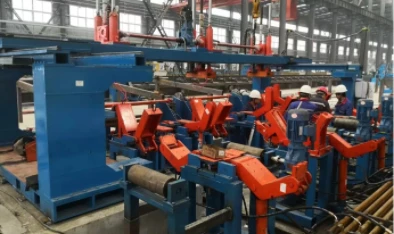Coil Unwinding and Material Feeding Solutions for Efficient Production Processes
The Importance of Decoilers and Feeders in Manufacturing
In the realm of manufacturing, efficiency and precision are paramount. As industries strive to optimize their production processes, the significance of decoilers and feeders has become increasingly prominent. These machines play a crucial role in ensuring that materials are fed into production lines seamlessly, reducing downtime, and enhancing overall productivity.
Understanding Decoilers and Feeders
Decoilers are devices designed to unwind and straighten coils of materials, typically metal strips, to prepare them for further processing. When materials arrive at a manufacturing facility, they often come in large rolls. The decoupling process involves unrolling these materials while maintaining their integrity and preventing any potential damage.
Feeders, on the other hand, are machines that ensure a consistent and precise supply of these materials to subsequent manufacturing processes, such as stamping, cutting, or welding. They regulate the flow and alignment of material, allowing for automated systems to operate smoothly without interruptions.
The Role of Decoilers
Decoilers serve multiple functions in a manufacturing setup
1. Material Handling Decoilers simplify the handling of heavy material coils. They are designed to support various coil weights and dimensions, ensuring safety and efficiency in the manufacturing environment.
2. Straightening Unevenly wound coils can lead to complications in further processing, such as misalignment or defects. Decoilers incorporate systems that straighten materials as they unwind, maintaining the material’s condition.
3. Automated Integration Modern decoilers can be integrated with automated systems, allowing for real-time adjustments in speed and tension based on the production requirements. This adaptability is essential for high-speed manufacturing lines.
The Functionality of Feeders
Feeders complement decoilers by ensuring that materials are fed into production machinery at the correct pace. Their importance can be highlighted through several key aspects
decoilers and feeders

1. Precision Feeding Feeders ensure that every piece of material is delivered accurately to its processing location. This precision minimizes waste and enhances the quality of the final product.
2. Speed Regulation In a fast-paced manufacturing environment, consistency in feed rates is critical. Feeders can be adjusted to match the speed of production machinery, reducing the risk of jams or slowdowns.
3. Versatility There are various types of feeders, including pneumatic, mechanical, and electromagnetic feeders, each offering unique benefits. This versatility allows manufacturers to select the best option based on their specific production needs.
Impact on Production Efficiency
The integration of decoilers and feeders into manufacturing processes can dramatically improve production efficiency. By providing a streamlined flow of materials, these machines minimize manual labor and reduce the risk of human error. This automation not only speeds up the production line but also allows for better resource allocation.
Additionally, with reliable decoiling and feeding solutions, companies can achieve higher levels of quality control. Consistent material delivery and alignment lead to more precise machining, reducing waste and enhancing product consistency.
The Future of Decoiling and Feeding Technology
As industries continue to advance, the technology behind decoilers and feeders is evolving. The incorporation of smart technology, like sensors and AI-driven systems, is changing the landscape. These advancements enable predictive maintenance, real-time monitoring, and enhanced automation.
Moreover, manufacturers are increasingly focusing on energy efficiency and sustainability in their operations. Newer feeder and decoiler systems are designed to consume less energy and produce less waste, aligning with global trends toward eco-friendly manufacturing practices.
Conclusion
Decoilers and feeders are indispensable components of the modern manufacturing process. Their roles in material handling, precision feeding, and overall production efficiency cannot be overstated. As technology continues to evolve, the future of these machines promises even greater improvements in productivity, sustainability, and cost-effectiveness. Manufacturers that invest in high-quality decoiling and feeding systems will undoubtedly gain a competitive edge in an increasingly demanding marketplace.
-
High Frequency Straight Seam Welded Pipe Production Line-BzZhou Xinghua Machinery Equipment Manufacturing Co., LTD.|Precision Welding, High EfficiencyNewsJul.30,2025
-
High Frequency Straight Seam Welded Pipe Production Line|BzZhou Xinghua|Precision Welding&EfficiencyNewsJul.30,2025
-
High Frequency Straight Seam Welded Pipe Production Line - BzZhou Xinghua|Precision Engineering&EfficiencyNewsJul.30,2025
-
High-Frequency Straight Seam Welded Pipe Production Line-BzZhou Xinghua Machinery Equipment Manufacturing Co., LTD.NewsJul.30,2025
-
High-Frequency Straight Seam Welded Pipe Production Line-BzZhou Xinghua Machinery Equipment Manufacturing Co., LTD.|Precision Manufacturing, High EfficiencyNewsJul.30,2025
-
High Frequency Straight Seam Welded Pipe Production Line-BzZhou Xinghua Machinery Equipment Manufacturing Co., LTD.|Precision Steel Pipe Manufacturing&Industrial EfficiencyNewsJul.29,2025


